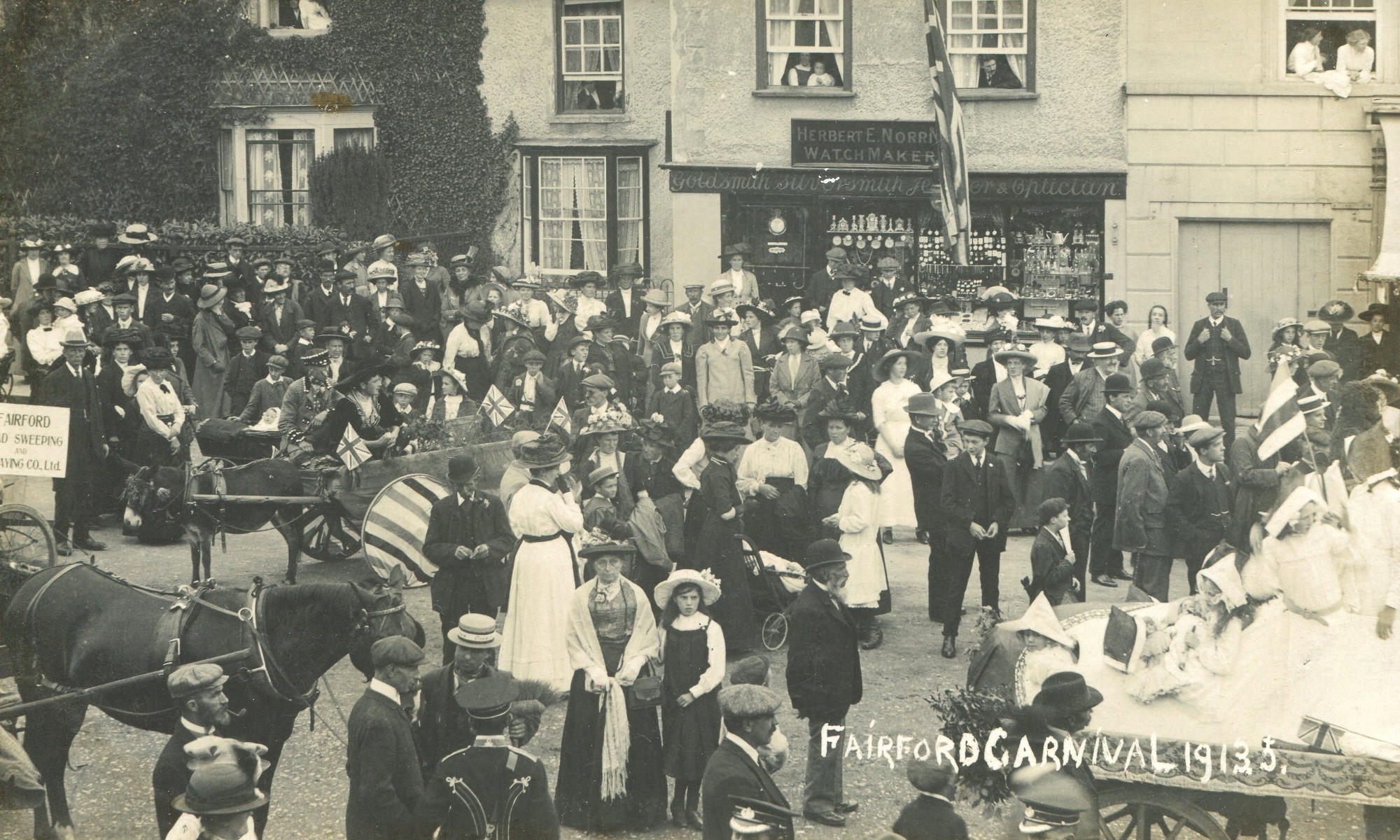The Oxpens
These ancient oxpens used to accommodate pairs of oxen for ploughing. The building and the site was restored after the Ernest Cook Trust took over the Estate in the 1950s. The used to farm with oxen in Gloucestershire up to the 1960s.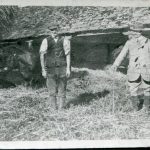
The photograph shows Alex Iles, farmer of Park Farm and with his stockman, William Westbury in the early 20th century when the enclosure was in use.
The site appears on 19th century maps but probably dates from much earlier as there is a mention in a 17th century documents for Wurmstalls [animal enclosure] near the Greate Greene.
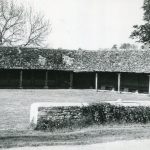 In the early 2000s the some of the old Cotswold stone tiles were stolen and the photo shoes after this has happened. They were later replaced and the site tidied up and is now a picnic site.
In the early 2000s the some of the old Cotswold stone tiles were stolen and the photo shoes after this has happened. They were later replaced and the site tidied up and is now a picnic site.
Fairford Waterworks and Gassons Field tower
The tower in Gassons field is a water tower. It was gravity fed from the res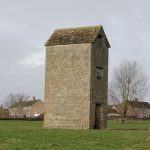 ervoirs in the woodland between Pitham Brook path and the Quenington Road that served Dynevor Terrace. These two reservoir were fed from a pump in the Fairford Mill through pipes across the field and were put in place in the early 20th century.
ervoirs in the woodland between Pitham Brook path and the Quenington Road that served Dynevor Terrace. These two reservoir were fed from a pump in the Fairford Mill through pipes across the field and were put in place in the early 20th century.
In the water tower was a large tank under which water tank on a cart was place was filled by pulling a chain/rope to relese the water.
See attached article by Syd Flatman for further information Fairford waterworks
Fairford Park Obelisk
The Obelisk
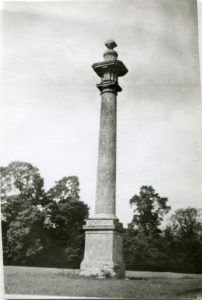
Many of you will have noticed the obelisk which stands isolated in a field off Leafield Road. It is Grade II listed and described as a Votive Column with a large square ashlar base with moulded plinth and cornice, unfluted Doric column with square section of entablature, surmounted by small cylindrical cap with ball finial set within square. There is no inscription.
It was built between 1751 and 1761 at which time the formal gardens of Fairford Park were being landscaped by James and Esther Lambe. The obelisk is in direct line of sight 1,220 meters from the north facing front entrance of the House. It would originally have been viewed through a long avenue of trees. If you stand at the back of the Stables occupied by the Ernest Cook Trust you have a splendid view of the Obelisk.
Fairford Workhouse
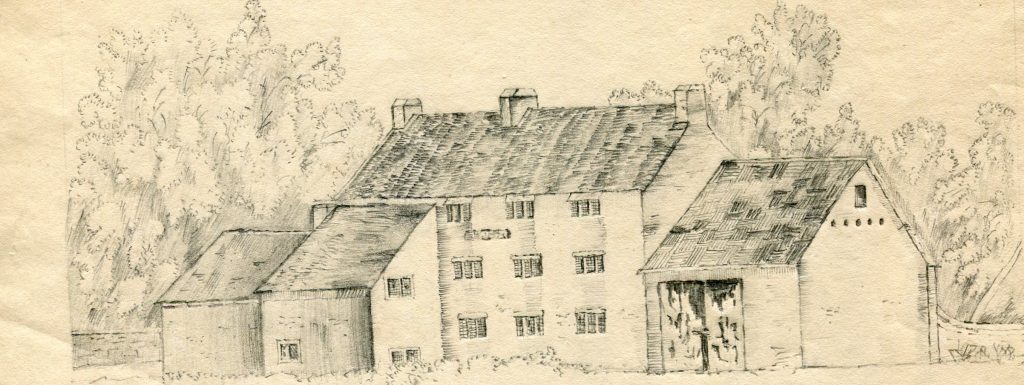
Fairford Workhouse, the ‘House of Industry’ opened in the Croft in 1773. There were 23 inmates in 1803 when the men dug stones in ‘ye Crofts’ and the women were paid 8d per pound spun flax and 6d per pound of woven sheeting. From that year’s income of £37, the Governor was paid a salary of £15, Barber Cowley received 6s 6d for ‘shaving ye old men’. Sarah Cowley had a new pair of stays costing 2s 6d; the inmates had 4s 3d between them to spend at the November fair, and the rest was expended on a hundredweight of soap, pig killing, funerals, tin cups and Epsom salts. The work house was pulled down in 1870 and the stones used to build the Infants’ School. It was approximately on the site of where Fairford Hospital is now.
Taken from June Lewis’s History of Fairford. 1982
Fairford Brickworks
Fairford Brickworks existed for about 70 years from c 1850- 1920. It was at Waiten Hill on a 10-acre site north of Cirencester Road. Today the barns are still there but the kiln is gone. The chimneys are no longer there but the base remains at about 6 foot. Today the barns are private homes. It made red bricks and clay water pipes and production ceased when the seam of red clay ran out. Thanks to Syd Flatman for this information and through him FHS is lucky enough to have a Fairford ‘Wane’ brick, donated by Bill Lanchbury.
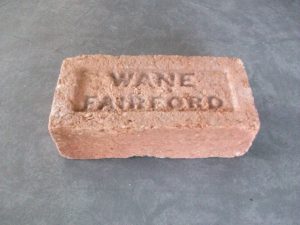
Around Fairford you can see buildings made of red brick e.g. Fairford Hospital and some houses in West End.
Below are entries from the trade directories from 1850 until 1910; it must have closed shortly after that.
1850, 52, 59 John Hurst Wane wine & spirit merchant brick & tile maker
1868 William Wane brick, tile and pipe maker
1879 William Dunn brick, tile and pipe maker Waiten Hills
1885 William Dunn brick, tile and drain pipe maker Waiten Hills
1889 William Dunn brick, tile and drain pipe maker Waiten Hills
1894 William Dunn brick, tile and drain pipe maker Waiten Hills
1897 William Dunn brick, tile and drain pipe maker Waiten Hills
1902 William Dunn brick, tile and drain pipe maker Waiten Hills
1906 Edward Hill brick, tile and drain pipe maker London Street
1910 Edward Hill brick and tile Waiten Hills
Wings School, Fairford
A small advertisement in the Birmingham Daily Post of 16 August 1944 announced the imminent arrival of a new school in Fairford. The advertisement stated: “COMMONWEAL LODGE, from Devon, OPENING AS “WINGS” AT FAIRFORD, GLOUCESTERSHIRE, SEPTEMBER 1944. Progressive approved School for Girls. Individual Tutorials. Music, Riding included.” Commonweal Lodge had been founded by William Webb in 1916 on his estate at Purley in Surrey. In 1941 the school had to move to Ardock Lodge in Lewdown near Okehampton, Devon as its building at Purley were taken over by the military. Three years later the school took up residence in Fairford in the buildings of The Retreat, a privately-run asylum which had been founded by Alexander Iles in 1822 and was owned by Dr A C King-Turner when it closed in 1944. However, the advertisement is slightly misleading as “Wings” appears to have been an offshoot of Commonweal Lodge School which returned to its original home at Purley at the end of the Second World War and remained there until it closed in 2010.
As the advertisement mentioned, riding was a very important aspect of the school’s activities and many of the almost 100 pupils brought their own ponies to school. “Wings” sponsored the Fairford Horse Show and Gymkhana which was held in the grounds of Fairford Park on 21 July 1945 and several of the girls took part in the show. The event was organised by the school’s bursar, Major Frank Edwards, and the proceeds were donated to the Fairford Cottage Hospital. The event was repeated the following year and was even more successful. One of the young riders who achieved national prominence in the sport was 11-year old Patricia Moss who jumped at the London Horse Show in June 1946. She was an outstanding rider having competed at horse shows since the age of four and was frequently mentioned in newspaper reports on riding events. Pat Moss later turned her focus to rally driving having been taught to drive by her brother Stirling Moss, one of Britain’s most famous Formula One racing drivers. She became one of Britain’s most successful female rally drivers becoming European Ladies Rally Champion five times in the 1950s and 1960s.
Pat Moss was not the only pupil of “Wings” to appear in the local and national press. Sisters Patricia and Diana Selous were pictured in the Gloucestershire Echo of 19 June 1946 with a horse named Winged Pan which apparently walked into the music room when it heard the sisters playing the piano and violin! Diana Selous and Pat Moss both won prizes at the Gloucester and District Horse Show which was held on 27 July 1946 when Pat Moss was the only competitor to achieve a clear round. Unfortunately the month ended on a less happy note on the 31st when one of the horses was knocked down by a Royal Air Force lorry in Horcott Road; both rider and pony sustained injuries. The emphasis on horse riding was no doubt due to the influence of the Principal of the school, Mrs Joan Hilsden, who had previously been the proprietor of a riding school in Felixstowe. Mrs Hilsden as well as teacher Noreen Morley and pupils Pat Moss, Diana Selous and Pamela Trotman had all competed at the National Horse Show at White City in June 1946.
Sadly the success at horse shows does not appear to have been accompanied by 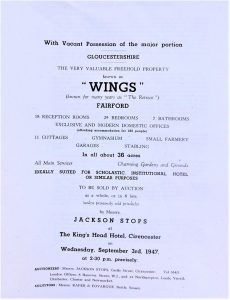 financial success and in September 1947 the buildings were put up for sale; the sales brochure giving an indication of the size of the etsablishment. In 1948 the property was bought by Gloucestershire County Council and in August the Council requested tenders to build a new block and renovate the existing buildings. In December the Council announced that the site would become a special school for up to 80 residential pupils with learning and behavioural difficulties. The school opened in May 1950 as Coln House School which finally closed in March 2017.
financial success and in September 1947 the buildings were put up for sale; the sales brochure giving an indication of the size of the etsablishment. In 1948 the property was bought by Gloucestershire County Council and in August the Council requested tenders to build a new block and renovate the existing buildings. In December the Council announced that the site would become a special school for up to 80 residential pupils with learning and behavioural difficulties. The school opened in May 1950 as Coln House School which finally closed in March 2017.
However this was not the end of “Wings” as the school moved to Charlton Park near Malmesbury. Although still under the management of Mrs Hilsden there seems to have been less emphasis on equestrian activities and more on practical skills such as shorthand and bookkeeping. Post certificate and finishing courses were offered for girls up to the age of 19. Unfortunately the school failed to prosper for very long at Charlton Park and in November 1953 the Principal and two of her staff filed for bankruptcy thereby bringing an end to “Wings” School.
The Thames and Severn Canal
On 17th of March 2010,Bruce Hall, of the Cotswold Canals Trust gave a talk to the Society about the 36-mile journey from the Severn to the Thames through the industrial area of the Stroudwater Navigation to the rural Thames and Severn Canal. The canal passed within a few miles of Fairford and traces of it can still be found at Kempsford and Dudgrove today. The most important cargo was coal especially from the Forest of Dean which was needed to supply power to the mills of the Stroud Valley.
The Stroudwater Navigation opened in July 1779; construction of the Thames and Severn Canal started at the western end in 1783 and the first barge entered the canal at Wallbridge in 1785 by which time the canal had probably reached Chalford. The Sapperton Tunnel, the third longest canal tunnel ever constructed in Britain, took five years to complete. In July 1788 much of the tunnel structure was complete when King George III and family visited the site; the stretch from the Coates portal eastwards is called King’s Reach in his honour. The first barge passed through the tunnel in April 1789.
On 19th November 1789 the first barge reached Lechlade, an occasion which was celebrated by a ball, a bonfire and a 12-cannon salute from nearby Buscot Park. However, competition from the railways in the 19th Century was too much for the Thames and Severn and this, along with continuing problems of excessive leakage, caused its closure in 1933.
In 2009 the Cotswold Canals Trust acquired Inglesham Lock and the Inland Waterways Association raised funds to completely renovate the old lock. The Waterway Recovery Group cleared much of the overgrown vegetation from the disused cana
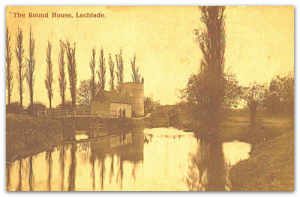
The restoration of the Stroudwater Navigation is well under way. Pictures of abandoned industrial sites show how the site has been transformed into the more modern use of housing and leisure. Bridges have been replaced by Gloucestershire County Council, towpaths reinstated and what were barriers of new roads and motorways have been turned into surmountable challenges. In some places the course of the River Frome has been a useful diversion.
Interesting facts
- The bottom of locks were built concave to withstand water pressure from the vertical walls
- The Canal was originally 7 feet deep but has not been dredged so deeply. Leisure-craft do not need that depth and it was necessary to avoid disturbing the pollution of the sediment from the industrial era
- The flat-bottomed Trow had a removable mast that was used on the tidal reaches of the River Severn up to Worcester. It was 16 feet wide and 68 feet long and built to carry coal and goods only as far as Brimscombe Port. Here the loads were transformed to Thames barges. Later narrow boats 7 feet wide and 70 feet long were more commonly used and as a result the locks were shortened about 1841-42 – this was also a water-economy measure
- The Lengthsmen and their families who lived in the five Roundhouses along the Thames & Severn were responsible for keeping their stretch of water clear and also looked after the lock if there was one
- The new bridge opened at Stonehouse in 1994 was the first ever plastic bridge. The building there was used by Sperry’s Gyroscope during World War II and had a gun emplacement on top
- The Severn-Thames link is 36 miles long with 56 locks, the Thames and Severn from Wallbridge to Inglesham is 28.5 miles long with 42 locks
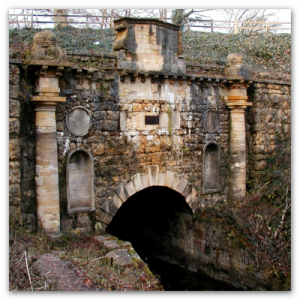
More can be learnt at the Cotswold Canal Visitor Centre a & Canal Shop, Bell House, Wallbridge Lock, Stroud, GL5 3JS
Open 10am — 1pm Monday — Saturday throughout the year and at any other time that the green flag is flying!
Telephone 07582 286 636 or visit www.cotswoldcanals.com.
Further reading
The Thames and Severn Canal through time by David Viner, 2013
The Stroudwater and Thames and Severn Canals from old photographs. Vols 1-3 by Edwin Cuss and Mike Mills, 2010-3
Fairford Mill
The Mill Buildings
There has been a mill in Fairford since Medieval times. The mill even gets a mention in the Domesday book.
In 1086, there were actually three mills belonging to the Fairford Manor, one of which was on the site of the current mill.
In 1296 Fairford had a fulling mill, but by 1307 there were only corn mills. One corn mill was connected with Milton End farm and the other 2 mills were in demesne (that is, land retained by the lord of the manor for his own use).
In the 17th Century a mill was recorded where Mill Lane crossed the Coln. This is the main part of the mill that we see today. The left wing was added in 1827 and further alterations were made in 1841 and 1857. 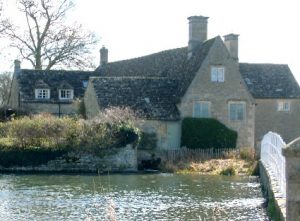
The Mill was used as a store between the First and Second World Wars and was derelict until it was converted to residential property in the 1950s. At that time, the machinery that had become dangerous was removed, but some of the machinery remained to minimise the impact on the environment around the mill. Consequently, there are still five mill sluices in place – three of them under the buildings.
The Fairford estate was acquired by Ernest Cook in the 1920s and the Mill later came under the care of the Ernest Cook Trust. The Mill house and adjacent Mill cottage were renovated and the Mill is back in service – this time as holiday lets.
It is likely that the early mill was operated on the lord of the manor’s behalf by villeins or by serfs in fulfilment of their feudal obligations.
In 1791, William Carter was a Miller in Fairford, but it’s not clear if this was at Fairford Mill. More definite news of this mill’s occupants comes from Pigot’s Directory of the 1830s. There are two entries for millers in Fairford. The first is Robert Bosberry of Fairford Mill, whose occupation was as a miller, and the second entry is for Henry and Robert Tovey of Fairford who were also millers by occupation. 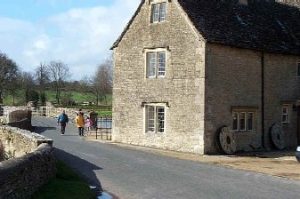 Between 1839 and 1847 Messrs Tovey were the millers at Fairford Mill. From 1889 until 1906 the Fairford Mill resident was Mr Richard Cole; a farmer, coal merchant and miller.
Between 1839 and 1847 Messrs Tovey were the millers at Fairford Mill. From 1889 until 1906 the Fairford Mill resident was Mr Richard Cole; a farmer, coal merchant and miller.
The last millers were the Bartletts, who moved here from Arlington Mill in 1910. They ran the mill until the First World War, but from 1919 there is no record of any millers working in Fairford.
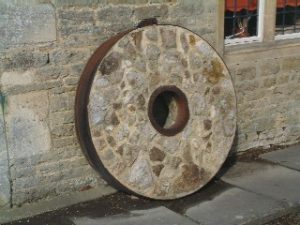
Lesley Pincombe
Fairford Branch Railway
The East Gloucestershire Railway Company was formed in 1861 to link Witney to Cheltenham, via Fairford. This original proposal had to be restricted to the 14-mile stretch between Witney and Fairford which was opened on 15th January 1863. In 1890 the East Gloucestershire Railway and Witney Railway (to Oxford) was absorbed into the Great Western Railway, the link to Cheltenham never being completed.
The initial timetable consisted of four passenger trains and two goods trains working each way on weekdays and by 1912 there were six daily passenger trains. At first there were seven intermediate stops between Oxford and Fairford; Kelmscott and Langford were added in December 1907, Cassington Halt in March 1936 and Carterton in October 1944. The branch became very important during the Second World War carrying munitions and troops with the proximity of seven major airfields; the railway actually crosses two of RAF Brize Norton’s taxiways.
After the war and throughout the 1950s there was a gradual decline in traffic on the branch back to four trains each weekday and which eventually culminated in the closure of the railway on 18th June 1962. The last public train running having run two days earlier. Today there is an industrial estate on the site of Fairford railway station now but there are still remains of the line marked by trackways and bridges. 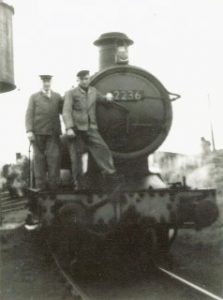
Loco 2236 at Fairford Station
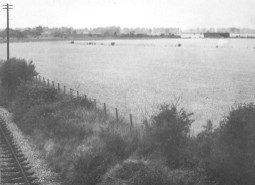
The train was so slow building up steam to Lechlade that mushrooms could be gathered in this field on the other side of Fairford Bridge and the train reboarded.
Photographs courtesy of Jean Bennett
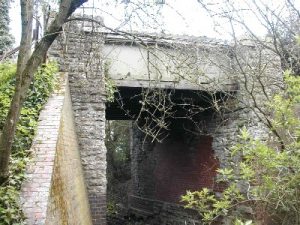 Bryworth Bridge near Fairford, 2006
Bryworth Bridge near Fairford, 2006
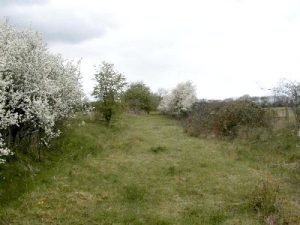
Railway Bed at Fairford, 2006
Photographs Chris Hobson
Further reading:
Branch Line to Fairford by Vic Mitchell and Keith Smith in association with Richard Lingard. Middleton Press, 1988 ISBN 0 906520 52 5
http://www.disused-stations.org.uk
http://www.fairfordbranch.co.uk
Farmor’s School and Fairford Community Centre
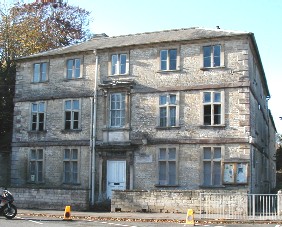 Farmor’s School opened as Fairford Free School on 24th November 1738. The school’s first schoolmaster was Jacob Kuffeler, a descendant of an ancient and prominent Dutch family. The building cost £543.8s, and consisted of a schoolmaster’s house and 2 classrooms with cellar and outbuildings including a brewhouse and a well in the rear yard. There had previously been several legacies to provide education in Fairford. In 1670 Lady Jane Mico founded a charity to provide apprenticeships for ” 4 poore Boys”, and in 1701 Mary Barker, daughter of Andrew Barker, Lord of the Manor of Fairford, left money for investment to raise funds for teaching poor boys to read and write. Later Elizabeth Farmor, Andrew Barker’s granddaughter, left £1000 in her will, specifically to build a school and pay a schoolmaster. The school originally had accommodation for 60 boys, aged between 5 and 12, and if Fairford children did not fill all the places, numbers could be made up from the surrounding villages. Boys could be “turned away” for bad behaviour, and left school to start work at the age of 12.
Farmor’s School opened as Fairford Free School on 24th November 1738. The school’s first schoolmaster was Jacob Kuffeler, a descendant of an ancient and prominent Dutch family. The building cost £543.8s, and consisted of a schoolmaster’s house and 2 classrooms with cellar and outbuildings including a brewhouse and a well in the rear yard. There had previously been several legacies to provide education in Fairford. In 1670 Lady Jane Mico founded a charity to provide apprenticeships for ” 4 poore Boys”, and in 1701 Mary Barker, daughter of Andrew Barker, Lord of the Manor of Fairford, left money for investment to raise funds for teaching poor boys to read and write. Later Elizabeth Farmor, Andrew Barker’s granddaughter, left £1000 in her will, specifically to build a school and pay a schoolmaster. The school originally had accommodation for 60 boys, aged between 5 and 12, and if Fairford children did not fill all the places, numbers could be made up from the surrounding villages. Boys could be “turned away” for bad behaviour, and left school to start work at the age of 12.
From the beginning there were close ties with St. Mary’s Church, the schoolmaster being required to conduct what we would now call a Sunday school and the Vicar giving scripture lessons at the school. The Vicar was usually one of the Governors of the school. The building was also used for Church meetings out of school hours.
The school was so successful that in the early 1800’s it was suggested that Fairford’s girls should also receive an education. At that time it was considered unnecessary to educate girls, and there was considerable opposition to the idea. Eventually the matter went to litigation. The Court made the enlightened decision that the original foundation did not specifically exclude females, and girls could be admitted. The school buildings were extended and a Girls School opened in 1815. It was totally segregated and run separately by a schoolmistress. The boys’ accommodation was upstairs and approached by an outside staircase, and the yard was divided by a stone wall to separate the boys and girls.
In 1871, having been sanctioned by Parliament and approved by the Charity Commissioners, the funds from Lady Jane Mico’s apprenticeship charity were amalgamated with those from Mary Barker and Elizabeth Farmor, to form a new educational charity, administered by trustees, which still continues today.
Co-education came to Fairford in 1922, when the boys and girls schools were combined under one Headmaster, Mr. Herbert Hedges, and the school changed its name to Farmors Free School to honour its major benefactoress. A plaque on the school wall pays tribute to the remarkable service of Herbert Hedges who served as Headmaster of the school for 25 years and Churchwarden for St Mary’s church for 38 years. A second plaque commemorates an earlier Headmaster, Richard Green, who died in 1767, recording “the uncommon assiduity and abilities with which he discharged the duties of his profession”.
From Victorian times, the school was the centre of education in the community, and there are records of the Vicar giving lectures on advanced subjects such as “Electricity”. Adult education classes started officially in the building in 1925, when the Fairford Evening Institute was formed. Initially, only vocational subjects were studied, but later the range was extended to include arts and recreational subjects.
In the post-war period of educational growth, after the Secondary Education Act, the building became the Secondary School for the whole area, including Lechlade and surrounding villages, and became very overcrowded. Gloucestershire County Council, the statutory education authority, built a new secondary school, Farmor’s School, in Fairford Park and in 1961 the pupils moved out of the old school buildings. In return for the new school, the old building passed into the ownership of GCC, and became the centre for all sorts of community activities, meetings, playgroups, old peoples clubs, but particularly the Youth Club. By the mid-1960s, there was a large and thriving Youth Club with a full time Youth Leader living in the building and dividing his time between the Centre and the new school. The Council had an office and the County Library also used part of the building. Unfortunately, GCC was not in a position to spend money on maintenance and modernisation, and, though reports were made on work which needed doing, it was not forthcoming.
In 1977 the people of Fairford decided to make the refurbishment of the Community Centre its official Silver Jubilee project. Money was collected by public appeal, and the old building was redecorated, re-fitted and adapted, and reopened in February 1979. For some time there was a period of greatly increased community activity and enjoyment, new clubs and societies were started to take advantage of the improved facilities, and the usage was high. However, as the years passed, the building once again began to deteriorate. New health and safety regulations meant that the kitchen was deemed inadequate and the heating and electric wiring were unsatisfactory. By the year 2000, the GCC had decided that it would be uneconomical to maintain the building to the standard required, and it was put on the market.
St’ Mary’s PCC and Fairford Town Council were both interested in acquiring the building for largely the same purposes, and it quickly became apparent that co-operation would be more productive than competition. A joint committee was formed to investigate the state of the building and consider its future possibilities, and in November 2002 the building was bought for the town. The PCC and Town Council each purchased part of the building with the intention of raising money for restoration and refurbishment and then managing the building as a whole for the benefit of Fairford and to meet the changing needs of its people for the foreseeable future. After serving the town for almost three centuries the building was completely renovated and extended in a one and a quarter million pound renewal project which brought it up to 21st century standards and gave it yet another new role in the community.
In 2018 Fairford Community Centre celebrated its tenth Anniversary and Farmor’s School celebrated its 280th anniversary.
